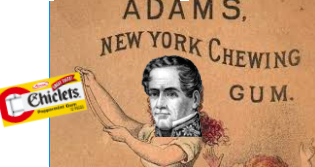General Santa Anna and Chicle

May 14, 2018
Many thousands of people spend their days chomping away at a piece of gum, a ubiquitous “candy” in the modern world, but, it is doubtful they ever question how gum came to be. Was it a random invention of the 20th century? Was it created by some ancient civilization? Was it an accident bound to happen in the 19th century? In a way, these all have an element of truth to them.
Gum was initially invented to quell man’s desire to masticate, a fancy word meaning to chew, a habit many people still have today. I often ask people why they are always chewing gum, and their answer isn’t always very impressive: many chew gum because they have to do something, they have to have something in their mouths. For this same reason, gum was developed throughout the ancient world. Mayans, Aztecs, Ancient Greeks, and even the Neolithic Finnish population used natural components such as mastic and chicle resin to create a piece of chewing gum with antiseptic properties in efforts to maintain oral hygiene. The Native Americans also produced something similar to gum made from the sap of spruce trees, an idea copied by New Englander John B. Curtis, who in 1848 began selling and mass producing gum as part of the State of Maine Pure Spruce Gum Company. Demand for gum would increase over the years which called for innovation. In 1869, William Semple patented the first sweetened form of chewing gum. This innovation, however, wouldn’t be enough to captivate the world. For that, the world would need a retired 74-year-old Mexican general who can be found at the North Pole.
General Santa Anna, the former almost-dictatorial ruler of Mexico had an integral role in the advancement of chewing gum. After disappointing his country in the Mexican American War, Santa Anna was despised by his people and was forced into exile in several Latin American countries before ending up in Staten Island, New York, where he would stay until the end of his life. En route to the United States, General Santa Anna transported a shipment of chicle, a natural South American sap, hoping to use it to produce a more effective and affordable buggy rubber tires. When his plan failed, he was left destitute and began chewing the chicle, a popular custom among the Mexican people. Meanwhile, the American assigned by the U.S. to aid the General, Thomas Adams, began experimenting with the chicle and found that he could profit from producing chewing gum and so he did. He opened his company, naming the product Chiclet after the sap from which it was made. By introducing several flavors and colors that made the treat enjoyable, Adams was able to start a trend that lasts to this day. However, the man who most contributed to the enterprise was the Mexican General Santa Anna. Without his contributions (bringing chicle to the United States), gum, as it is today, may have never existed.
Photo Credits to The Catalist, San Jacinto Museum, and Chiclet